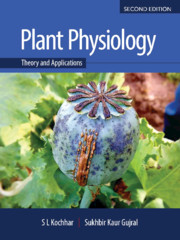Book contents
- Frontmatter
- Contents
- Foreword
- Preface to the Second Edition
- Preface to the First Edition
- Acknowledgements
- Some Common Abbreviations used in the Text
- Abbreviations for Units
- Unit I Water and Mineral Translocation in Plants
- Unit II Metabolism and Bioenergetics
- Unit III Growth and Development
- Unit IV Physiological Stress and Secondary Metabolites – Their Role in Metabolism
- Unit V Crop Physiology – An Innovative Approach
- Unit VI Breakthroughs in Plant Physiology
- Unit VII Some Experimental Exercises
- Glossary
- References
- Index
- Colour Plates
Chapter 17 - Ripening, Senescence and Cell Death
Published online by Cambridge University Press: 12 May 2020
- Frontmatter
- Contents
- Foreword
- Preface to the Second Edition
- Preface to the First Edition
- Acknowledgements
- Some Common Abbreviations used in the Text
- Abbreviations for Units
- Unit I Water and Mineral Translocation in Plants
- Unit II Metabolism and Bioenergetics
- Unit III Growth and Development
- Unit IV Physiological Stress and Secondary Metabolites – Their Role in Metabolism
- Unit V Crop Physiology – An Innovative Approach
- Unit VI Breakthroughs in Plant Physiology
- Unit VII Some Experimental Exercises
- Glossary
- References
- Index
- Colour Plates
Summary
Fruit Ripening
Fruit ripening is considered to be a terminal phase of development rather than a degenerative process. Fruits are classified into climacteric (exhibiting a ripening-associated respiratory burst, often accompanying a spike in ethylene production) or non-climacteric. Mature climacteric fruits can be ripened after detaching from the parent plant, a process that can be hastened by exposure to ethylene.
Morphological changes during ripening
(i) Change in fruit color
Fruits such as banana, pepper, tomato and citrus change color during ripening and become brightly colored. When immature, these fruits are green and catabolize chlorophyll on ripening by the identical pathway that operates in senescing leaves.
• The loss of chlorophyll uncovers underlying brightly colored, hydrophobic carotenoids located in chromoplasts. Carotenoids form fibrils, crystals or globules and are associated with specific proteins, fibrillins. Fibrillin genes are highly expressed at the stage of fruit ripening, leaf senescence and during the development of floral organs, as well as in response to several types of abiotic stresses. New carotenoids are synthesized via the isoprenoid pathway. The red carotenoid of tomato and bell pepper is lycopene The enzymes involved in lycopene synthesis, become significantly more active during Capsicum ripening (Figure 17.1) .
• Another source of fruit color is the pigmented water-soluble products of phenylpropanoid metabolism which accumulate in the central vacuole. Phenylpropanoid pathways originate with the amino acid phenylalanine and are complexed, branched, metabolic sequences with several control points that lead to biosynthesis of a diverse group of phytochemicals, including phenolics, tannins and flavonoids. Fruits like red grapes, cherries, red apples, black currants and strawberries are rich in anthocyanins. The development of anthocyanin coloration in fruits is the by-product of coordinated genes expression for flavonoid biosynthesis under the control of specific MYB transcription factors. Red and purple anthocyanins and yellow flavonoids are also responsible for the striking pigments of autumnal foliage in maple trees.
(ii) Change in fruit texture
Fleshy fruits become softer during ripening because of the chemical changes occurring in their cell walls which result in the loss of firmness. Hydrolytic enzymes become active and act on cell wall carbohydrates, de-esterify and depolymerise complex polysaccharides, thereby altering the physical qualities of the wall matrix as well as loosening cell-cell adhesion in soft fruits such as tomato and peach.
- Type
- Chapter
- Information
- Plant PhysiologyTheory and Applications, pp. 526 - 542Publisher: Cambridge University PressPrint publication year: 2020

